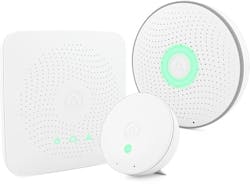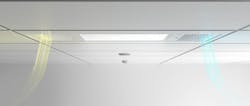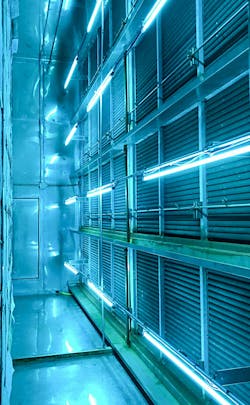Many people have heard the saying, “You are what you eat.” If you consume nutritious foods, then you could be a healthier person. Perhaps, like your diet, the same could be said about your environment. In that case, one might argue, “You are what you live in.” In that regard, if you are exposed to clean air, water and other natural elements, then you could be a healthier person.
Events occurring in our outdoor or indoor environments impact our health, quality of life and existence. The blazing forest fires in California, hurricanes, air and water pollution, structural erosion, COVID-19 and other airborne, waterborne or surface-spread viruses and diseases, for examples, can endanger our breathing, immune and organ systems, and other vital bodily functions. Medical settings, of course, are not immune to these environmental health hazards.
Spread of pathogens
“Healthcare facilities face a challenge in controlling airborne contaminants that come from a variety of reservoirs (soil, water, dust, organic matter) from exposing patients and staff,” Hoffmann noted. “Also, several airborne infections in susceptible hosts can result from exposures to clinically significant microorganisms carried by human hosts. Once present in the healthcare facility, these potential pathogens are an ongoing and invisible threat for healthcare-associated infections.”
SARS-CoV-2, the virus that causes COVID-19, poses an extreme opportunity for transference through the air and surfaces.
“Respiratory infections, including the highly infectious SARS-CoV-2, are acquired from exposure to pathogens contained in either droplets or droplet nuclei (bioaerosols),” she added. “Studies show bioaerosols spread around indoor spaces and linger in the air, depending on the number of air exchanges. Primary transmission of COVID-19 occurs via inhalation of infectious droplets and bioaerosols. In addition, when these bioaerosols settle onto surfaces in healthcare settings, they create the potential for fomite transmission via inanimate objects, such as countertops, patient care equipment, or door handles. Once contaminated, the surfaces are a risk transference to medical staff or patients.”
“The advent of the current pandemic and other events, including SARS, H5N1, MERS and Legionella outbreaks, have had a tremendous effect on the healthcare environment,” explained Pat Leach, Business Development Manager, Pure Air, Alfa Laval. “Airborne and waterborne transmission of these pathogens has been documented, requiring measures to protect and isolate critical path airways and waterways.”
Measuring healthcare environment quality and safety
Hospitals and healthcare systems must maintain the highest quality of environmental cleanliness and sanitization in order to deliver safe and effective patient care. Any exposure to bacteria, mold and other infectious organisms within healthcare settings can increase the risk of cross contamination and infections with patients.
COVID-19, certainly, has shined the light on the significance of environmental assessment and maintenance, expresses Andrew De Vries, Senior Manager, Strategic Sourcing, Valify Solutions Group.
“As there is an increased focus on air, water, and steam quality during the COVID-19 pandemic, hospitals and health systems may be seeking new vendors in these categories or expanding their scope of services with existing vendors,” De Vries indicated. “For water quality in particular, an important factor to consider for this often-outsourced purchased services category includes a vendor’s ability to provide a field and technical services team to help manage chemical usage, particularly with regard to algaecide, chlorine, chlorine dioxide, and others. A reduction in these agents can support an organization’s green initiatives and may also result in additional cost savings.”
Bringing on water treatment service specialists also can help raise vital understanding and mitigation of waterborne diseases, such as Legionella, a serious type of pneumonia caused by bacteria that live in water, De Vries emphasized.
“Legionella can make people sick when they inhale contaminated water from building water systems that are not adequately maintained,” he noted. “According to the CDC, the number of Legionnaires’ cases reported has been on the rise in recent years. Health departments reported nearly 10,000 cases of Legionnaires’ disease in the United States in 2018 compared to approximately 3,500 in 2012.1 All professionals supporting a facility’s water management efforts should have specific competencies. These include the abilities to identify control locations and control limits (the range of values that are acceptable to reduce the risk for bacteria to grow and spread), to identify and take corrective actions if needed, to monitor and document program performance, and to communicate regularly about the program.”
Another area of concentration for monitoring is a heating, ventilation and air condition (HVAC) system, which is one of the major reservoirs of microbial contamination in healthcare, addresses Leach.
“The single most impactful challenge facing healthcare is the control and abatement of viable microbial contamination, which commonly is isolated within air, water and steam-based systems in healthcare environments,” he stressed. “This problem is becoming more concerning due to the increase of drug-resistant and multidrug-resistant pathogens, especially gram-negative bacteria. And consequently, the largest single source of gram-negative bacteria in hospitals are HVAC systems. Studies have demonstrated the presence of biofilms within the HVAC system harbor and grow many of the pathogens associated with healthcare-acquired infections (HAIs). Left unchecked, this poses the greatest risk to immunocompromised patients, as well as staff and visitors.”
One solution that focuses on removing harmful microorganisms that generate within HVAC systems is the Alfa Laval Pure Air system. “Our evidence-based design technology has been proven to eliminate surrogate pathogens associated with HAIs from a moving airstream of 440 fpm (feet per minute) at an efficacy of 99.999 percent in a single air pass,” Leach continued.
Like water quality, air quality requires specialized evaluation, measurement and support. How exactly is that handled?
“The biggest challenges that we have seen in terms of indoor air quality is balancing heathy air, which is critical in healthcare settings, and high energy costs,” Callahan expressed. “It also is critical that air quality parameters are accurately measured and managed.”
More specifically, she added:
- “Airborne Particulates – The novel coronavirus and other viruses attach themselves to particles, and therefore must be minimized in the indoor environment. Even if your building has recently upgraded its filters, you need to be able to quantify the impact. Using the right data, your building can determine the ‘effective filtration rate’ and whether the healthy small particle levels are being controlled.
- Carbon Dioxide (CO2) – In order to verify that enough dilution air is being brought in, your building should have a reliable system to sense the amount of CO2 in the space and bring more in when needed. Next, your building should use a high-quality analytics platform to look at the CO2 levels of the outside air, supply air and room air. These readings can then be compared against science-based air quality standards to ensure adequate ventilation is controlling CO2 levels.
- Relative Humidity (RH) – When RH is lowered to the 0–40 percent range, respiratory immune defenses are impaired.2 At these RH levels, airborne droplets containing viruses evaporate and lighten, allowing the droplets to float longer and survive for a longer period of time. Due to these issues, your building should work to provide higher relative humidity levels, ideally in the range of 40–60 percent RH, especially in low humidity and in peak viral season.
- Total Volatile Organic Compounds (TVOCs) – Your building manager should be reviewing TVOC data and ensuring that it’s in an acceptable range. This involves a sensor system that identifies any increase in TVOCs from cleaning and sends a signal for more outside air until TVOC levels drop again.”
- Prior to the COVID-19 crisis, St. Francis Hospital and Medical Center in Connecticut brought in Aircuity for an environmental assessment. “In addition to gathering valuable data about the indoor environmental quality of the operating rooms, Saint Francis was able to implement a ‘safe standby’ mode in these suites,” according to a case study.3 “When the operating rooms were not in use, airflow could be reduced to save energy with Aircuity monitoring the condition of the space. If issues are detected, airflow is increased to design maximum until containment levels have subsided. Once the air is clean, ventilation levels are lowered again, saving energy.”
This process, in turn, enhanced staff satisfaction, building equipment function, and patient care. “The hospital also used the newly available data to provide verification for clinical personnel that air quality was not being sacrificed for energy efficiency. Clinical verification of humidity levels within the OR is another way that Saint Francis is able to deliver superior patient care. Facilities’ staff found that circuit boards and other internal components were previously being exposed to higher humidity levels than the manufacturer had intended. With humidity levels now staying constant, equipment performance has increased and spot problems have been eliminated.”
Similarly, Airthings for Business, a B2B air quality monitoring solution, helps gauge indoor air quality in long-term care and healthcare settings, which, consequently, has benefited the health and safety of personnel and those they care for, addresses CEO Oyvind Birkenes, Airthings.
“In Norway, our solution already is at work in some local nursing homes and healthcare centers,” he shared. “In terms of proven efficacy, one facility was able to report a significant reduction in the sick leave rate of their staff, after addressing issues with high temperatures and low humidity, ventilation, and excess use of hand disinfectants that lead to high airborne chemical exposure throughout the day. In addition to providing personalized indoor air quality data that can identify airborne threats in real time, our products are RESET accredited, meaning they are certified and proven to promote health and sustainability for the built environment.”
“Healthcare and medical facilities are under stricter guidelines and more pressure than ever to ensure that they are maintaining a healthy environment for patients, doctors, and medical staff,” he emphasized. “Poor indoor air quality in a hospital can be extremely dangerous as it can lead to an increased risk of infection for at-risk patients. Research has proven that low humidity levels impair the body’s immune system and allow viruses to survive longer in droplets, making people more vulnerable to airborne viruses. Ventilation and circulation for natural, fresh air is critical in hospital settings.”4
The quality of the utilities used in processing equipment, additionally, can have implications on the cleaning, disinfection, and sterilization of reusable medical devices, points out Jonathan A. Wilder, Ph.D., Managing Director, Quality Processing Resource Group, LLC.
“Many healthcare facilities do not follow the recommendations or requirements for steam, water and air in use in sterile processing,” Wilder indicated. “These are clearly laid out in AAMI and ASHRAE standards but are only checked when something goes wrong. Proper attention is not generally given to incoming water filtration and treatment. Water quality influences the maintenance schedule of anything that uses it. Steam quality affects sterilizer performance, instrument lifetime and corrosion. If the load is wet due to wet steam, that would require reprocessing any wet item or the entire load. Our audits compare the current situation to the specifications in AAMI ST79 and TIR34. We have helped clients with staining, corrosion, wet loads, failed indicators, and contamination issues, resulting in fewer or no interruptions to the flow of clean, sterile instruments from SPD to point of use.”
Natural disasters, especially, can create hazardous conditions with water and other elements, continued Wilder.
“I am concerned about potable water purity in areas where there have been multiple hurricanes and flooding,” he said. “The water table in those areas has been flooded, resulting in ‘stuff’ being dissolved in municipal water that normally isn’t. It’s the facility’s responsibility to provide water of consistent quality since municipal water can show variation. On-site filtration helps with this.”
Investing in air disinfection to control spread of infection
As COVID-19 progresses and air quality remains a priority in healthcare, many medical providers are adopting new cleaning systems for added support, such as UV disinfection.
“The Centers for Disease Control and Prevention (CDC) has confirmed airborne transmission of SARS-CoV-2 does pose a risk,” Dr. Mathur noted. “With regard to airborne pathogens, the potential transmission of respiratory viral infections, such as coronavirus, influenza, aspergillus and tuberculosis, has been established in scientific literature. Potential transmission also can occur during aerosol-generating procedures, such as cardiopulmonary resuscitation, bronchoscopy, surgeries, where droplets of infectious particles can be propelled into the air. Many facilities are implementing new protocols – including in-between surgical procedure air disinfection – to help prevent the risk of airborne transmission from aerosol-generating procedures.”
UVDI provides a range of UV disinfection products that help control the spread of pathogens from surfaces in rooms as well as from the air filtered through HVAC ducts, adds Dr. Mathur.
“Our UV-C based Indoor Air Quality products are used for air disinfection in leading hospital systems internationally,” he shared. “Germicidal UV-C is a proven technology to inactivate high-risk micro-organisms and has been recommended by the CDC and ASHRAE as an effective tool to prevent the airborne transmission of the virus. In addition to providing whole room disinfection, the UVDI-360 Room Sanitizer has been confirmed in independent testing to not affect the fit and filtration performance of tested 3M N95 respirators after ten decontamination cycles.”
Likewise, Jay Comeaux, President, EDM Facilities, which offers the UV Angel Clean Air UV-C air purification system, sees a growing desire among hospitals and medical settings to enhance environmental disinfection, however, while needing to weigh potential costs.
“While many facilities would like to initiate new technologies, it has become more difficult due to logistics, budgets, and the time implementation can take,” Comeaux emphasized. “Shielded upper room-level UV-C air purification is a proven effective addition to infection control protocols. As a matter of fact, the CDC made mention of this shortly after the COVID outbreak. Through the use of UV Angel Air technology, pathogen levels have been lowered in the air, staff absenteeism has improved, and workflow isn’t interrupted since the technology is an engineering control.”
The VidaShield continuous UV-C air purification system by NUVO, a division of Medical Illumination International, seamlessly integrates in to existing ceilings, treats the air and helps decrease contaminates and the potential for infections, points out Hoffmann.
“The use of VidaShield provides a noninvasive adjunct to reduce airborne bacteria, viruses, and fungi in the treated air and reduce the settling of bacteria and fungus from treated air on surfaces,” she explained. “This is important because untreated air samples on average range from to two to eight times more contaminated than surfaces. In two separate peer reviewed studies, reductions in patient cases of C difficile, MRSA, and VRE were reported, as well as total overall infection rates. In addition, the VidaShield combination of UV-C and air filtration has made a notable improvement in healthcare-related odors.”
Bottom line, environmental quality can’t be overlooked, given its critical impact on patient care, infection prevention, patient and staff safety, financial operations, and communities.
“In the US alone, approximately two million patients suffer from HAIs,” indicated Aaron Engel, Vice-President Business Development, Fresh-Aire UV. “HAIs are a significant cause of illness and death, costing the healthcare system tens of billions of dollars annually and resulting in up to 90,000 deaths. Not only are facilities looking to reduce HAIs, but they are also challenged by the current COVID-19 situation and keeping patients and staff safe during a pandemic.”
“At the on-set of the pandemic, Fresh-Aire UV disinfection systems were being used across Canada and the US to disinfect and extend the life of N95 respirators and other PPE,” Engel noted. “Our ceiling mount UV surface disinfection systems were being employed as an adjunct to conventional environmental cleaning practices designed to disinfect high-touch surfaces. Our in-duct- and HVAC- installed UV disinfection systems have been used to complement filtration, disinfecting pathogens in the air handler, drain pan and evaporator coil as well as the duct work, treating the air as it’s distributed through the ventilation system. The coronavirus has caused many facilities to re-think how they have been addressing their indoor air quality and what measures they can implement to lessen the chance of surface and airborne transmission.”
References
- 1Developing a Water Management Program to Reduce Legionella Growth & Spread in Buildings A PRACTICAL GUIDE TO IMPLEMENTING INDUSTRY STANDARDS, June 5, 2017, Version 1.1., https://www.cdc.gov/Legionella/downloads/toolkit.pdf
- 40to60RH.com, https://40to60rh.com/
- Aircuity Case Study, Saint Francis Hospital and Medical Center The Best Patient Care in the Best Environment, https://www.aircuity.com/wp-content/uploads/Aircuity-Case-Study_Saint-Francis-Hospital_F053118.pdf
- WHO Publication/Guidelines, Natural Ventilation for Infection Control in Health-Care Settings, https://www.who.int/water_sanitation_health/publications/natural_ventilation.pdf

Ebony Smith
Ebony Smith was previously Managing Editor for Healthcare Purchasing News.












